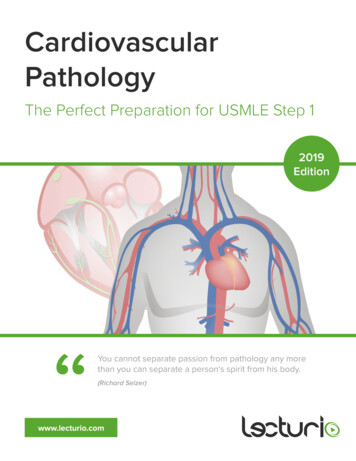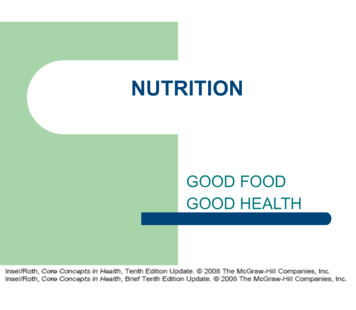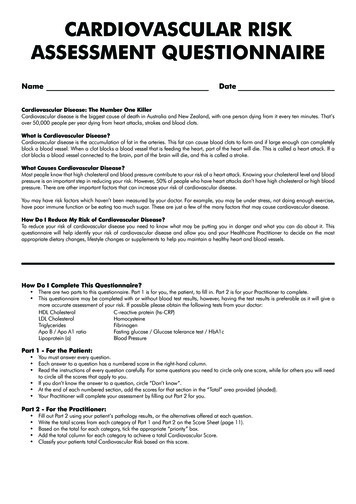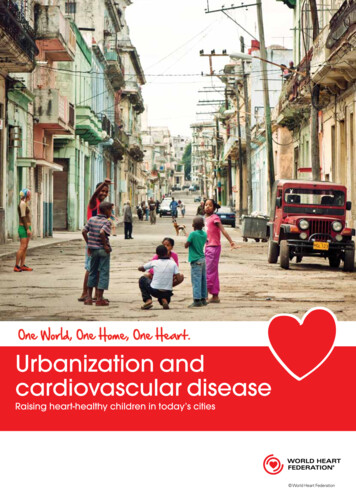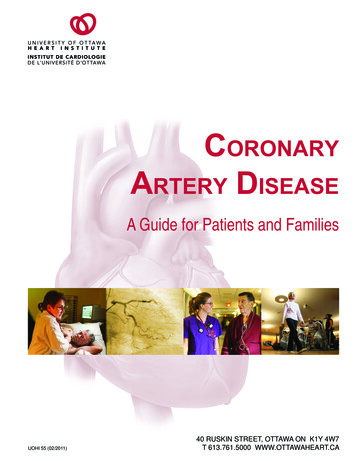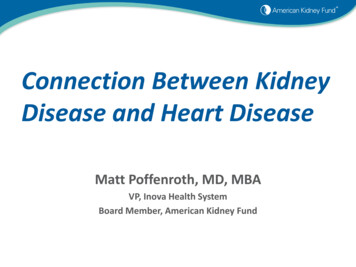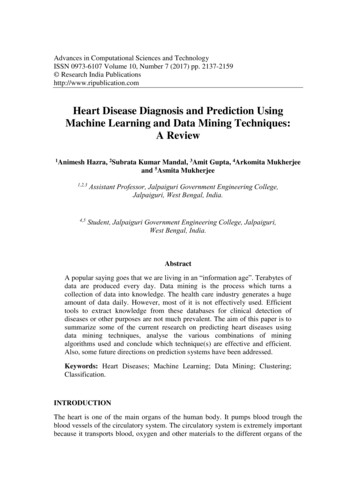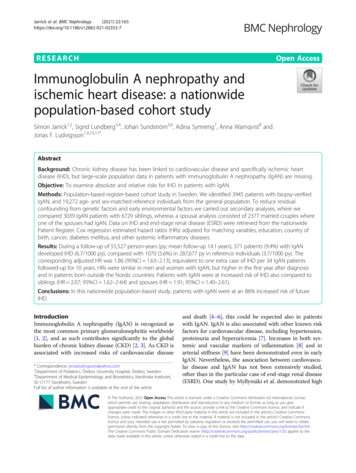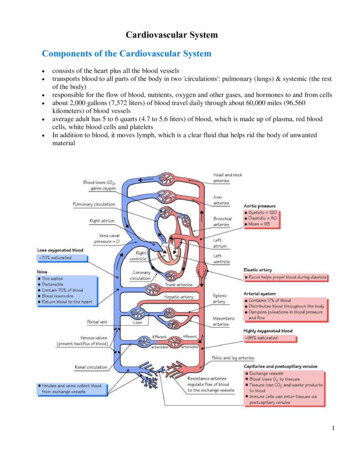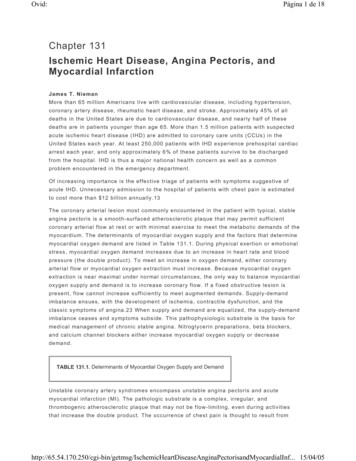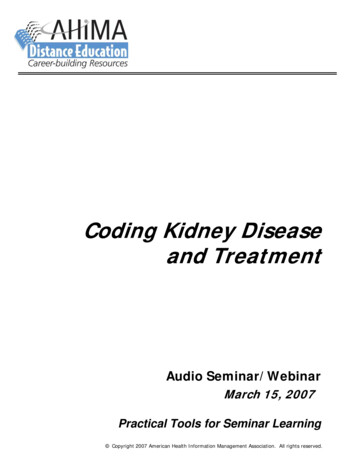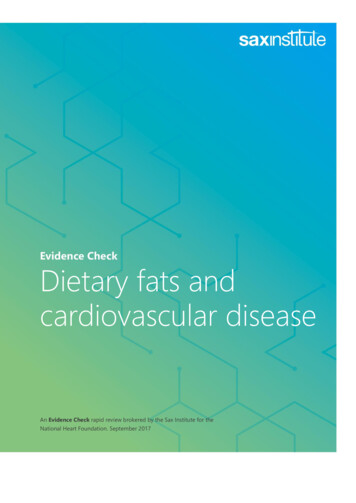
Transcription
Dietary fats andcardiovascular diseaseAn Evidence Check rapid review brokered by the Sax Institute for theNational Heart Foundation. September 2017
An Evidence Check rapid review brokered by the Sax Institute for the National Heart Foundation.March 2017.This report was prepared by:Professor Peter Clifton and Dr Jennifer KeoghUniversity of South AustraliaSeptember 2017 Sax Institute 2017This work is copyright. It may be reproduced in whole or in part for study training purposes subjectto the inclusions of an acknowledgement of the source. It may not be reproduced for commercialusage or sale. Reproduction for purposes other than those indicated above requires writtenpermission from the copyright owners.Enquiries regarding this report may be directed to the:Principal AnalystKnowledge Exchange ProgramSax @saxinstitute.org.auPhone: 61 2 9188 9500Suggested Citation:Clifton P and Keogh J. Dietary fats and cardiovascular disease: an Evidence Check rapid review brokeredby the Sax Institute (www.saxinstitute.org.au) for the National Heart Foundation of Australia, 2017.Disclaimer:This Evidence Check Review was produced using the Evidence Check methodology in response tospecific questions from the commissioning agency.It is not necessarily a comprehensive review of all literature relating to the topic area. It was currentat the time of production (but not necessarily at the time of publication). It is reproduced for generalinformation and third parties rely upon it at their own risk.2 DIETARY FATS AND CARDIOVASCULAR DISEASE OUTCOMES SAX INSTITUTE
Dietary fats andcardiovascular diseaseAn Evidence Check rapid review brokered by the Sax Institute for the National Heart Foundation ofAustralia. September 2017This report was prepared by Professor Peter Clifton and Dr Jennifer Keogh.DIETARY FATS AND CARDIOVASCULAR DISEASE OUTCOMES SAX INSTITUTE 3
ContentsGlossary. 5Executive summary. 6Background . 11Methods . 11Findings. 12Discussion of findings . 27Recommendations . 28References . 29Appendices . 354 DIETARY FATS AND CARDIOVASCULAR DISEASE OUTCOMES SAX INSTITUTE
GlossaryALAAlpha-linolenic acidCHDCoronary heart diseaseCHOCarbohydratesCVDCardiovascular diseaseDPADocosapentaenoic acidDHADocosahexaenoic acidEPAEicosapentaenoic acidHDLHigh density lipoproteinIHDIschaemic heart diseaseLALinoleic acidLCMUFALong-chain monounsaturated fatty acidsLDLLow density lipoproteinMIMyocardial infarctionMUFAMonounsaturated fatNHFANational Heart Foundation of AustraliaPUFAPolyunsaturated fatN3 fatsOmega-3 fatsN6 fatsOmega-6 fatsSFASaturated fatTCTotal cholesterolTFATrans fatty acidDIETARY FATS AND CARDIOVASCULAR DISEASE OUTCOMES SAX INSTITUTE 5
Executive summaryBackgroundOver the last six years the evidence in relation to saturated and polyunsaturated fat (PUFA) and heartdisease has been very strongly questioned by a small group of researchers and the media, and left thepublic very confused.The National Heart Foundation of Australia (NHFA) commissioned this Evidence Check to review the mostrecent evidence on dietary fats and cardiovascular health. Since the Heart Foundation published theirposition statement Dietary Fats and Dietary Sterols for Cardiovascular Health in 2009, there have been atleast six major meta-analyses regarding dietary fat and fish oil supplementation and cardiovascular health.Review questionsThis review aimed to address the following questions:1.What is the evidence regarding the association between dietary fat consumption and the incidenceof cardiovascular disease?2.What is the evidence regarding the association between dietary fat consumption andcardiovascular disease outcomes in patients with existing cardiovascular disease?3.What is the evidence regarding the effectiveness of manipulation of dietary fat intake asmanagement strategy for hypercholesterolemia?4.What is the evidence regarding:a.the association between dairy product intake and CVD outcomes?b.the association between coconut oil intake and CVD outcomes?Summary of methodGiven the brief of reviewing meta-analyses and systematic reviews with hard endpoints for heart attack,heart failure, cardiac death and atrial fibrillation, only peer reviewed literature (Pubmed, Embase andCochrane library of Controlled Clinical Trials) was searched with the search terms “dietary fat OR dietarysaturated fat OR dietary unsaturated fat OR dietary fish oil OR dietary omega 3 fats OR dietary omega 6 fatsAND heart disease”. Searches were limited to a period from 2009 to 18 November 2016. This produced 2621unduplicated publications. The addition of systematic review to the search terms reduced the number to528. This number was further reduced to 79 by the addition of the term meta-analysis. All meta-analysesthat specifically addressed each question were included (n 42) plus 2 systematic reviews and 9 individualstudies not included in the latest meta-analyses.Evidence gradingGiven that much of the evidence in relation to Question 1 came from cohort studies it can only be regardedas Level III evidence with a Grade of C (satisfactory) as it requires extrapolations from cohort studies and notinterventions. For Question 2, although this included Level I evidence, it can only be regarded as Grade D(poor) due to striking inconsistencies in the evidence and the meta-analyses. For Question 3, level I evidenceis available and would be given a Grade of B (good) but recommendations for long-term diet requireextrapolations from short term studies. For Question 4a, the evidence is level III and Grade C (satisfactory).Question 4b has insufficient evidence to grade.Although these ratings might be regarded as relatively low, they reflect the limited evidence base fornutrition compared with drugs, which have many large well-funded interventions on which to base policyand guidelines. As noted, much of the evidence comes from cohort studies and the associations seen in6 DIETARY FATS AND CARDIOVASCULAR DISEASE OUTCOMES SAX INSTITUTE
these studies are not evidence of causation. Long term intervention studies would be required and, to date,agencies such as the NHFA or the NHMRC have not funded such studies, which are difficult and expensive.Key findingsQ1: What is the evidence regarding the association between dietary fat consumption and the incidenceof cardiovascular disease?There is limited data on total fat and heart disease. The best most recent data is that from the combinedNurses’ Health Study and Health Professionals Follow-up Study from Wang et al1 which showed those in thehighest quintile of total fat had 16% lower total mortality. Thus, higher fat compared with high GI, low fibre,carbohydrate as consumed in the USA, is associated with better outcomes. This was due to 16% lowermortality due to high polyunsaturated fat (PUFA) intake and 11% lower mortality due to highmonounsaturated fat (MUFA) intake.Saturated fat was associated with an 8% increase and trans fats; a 13% increase in total mortality comparedwith carbohydrate. Thus, replacing 5% of energy from saturated fats with equivalent energy from PUFA andMUFA was associated with estimated reductions in total mortality of 27% and 13%, respectively. Thesefindings for total mortality were very similar looking at cardiovascular disease (CVD) mortality, althoughMUFA was not protective. Alpha-linolenic acid (ALA) was not associated with reduced mortality but marinefish oils were associated with a 4% reduction in mortality. PUFA was superior to MUFA for both total andCVD mortality in these cohorts.Li 2 examined the same American cohorts and found a 20% reduction in coronary heart disease (CHD)events with a low saturated fat diet compared with carbohydrate. Low quality carbohydrate (high GI starchand sugar) was positively associated with CHD. Replacing 5% of energy intake from saturated fats withequivalent energy intake from PUFAs, MUFAs or carbohydrates from whole grains was associated with a25%, 15%, and 9% lower risk of CHD. PUFA and MUFA were equivalent for prevention of CHD events butPUFA was superior to wholegrain carbohydrate.Although this data comes from only two cohorts combined, the updating of dietary information every fouryears adds a lot of weight to the findings, which are probably more reliable than larger meta-analysescombining weaker studies. In the Predimed study (Guasch-Ferre et al. 2015) a high total fat intake (bothfrom MUFA and PUFA) was associated with a 42–50% reduction in CVD and total mortality. 3De Souza 4 published the most recent meta-analysis of all cohort studies and found saturated fat andcarbohydrate were equivalent for CHD events and mortality in the most adjusted analysis (like the 2010 SiriTarino meta-analysis 5), whereas the least adjusted analysis was borderline for CHD risk and significant forCHD mortality.Thus, saturated fat is similar to or worse than total carbohydrate for CHD events but definitely worse thancarbohydrate for total mortality.Therefore, reducing saturated fat (and trans fat), and replacing it with PUFA and MUFA and carbohydrate ofany type, will lower total mortality. Replacing it with PUFA, MUFA and whole grains will lower CHD events.Replacing saturated fat with PUFA will lower events, CVD mortality and total mortality, and is clearly superiorto MUFA. PUFA can include linoleic acid (LA), alpha-linolenic acid (ALA) and fish oil.Meta-analyses by Farvid 6 and de Goede 7, and data by Wu 8 from the Cardiovascular Health Study, confirmthe clear benefit of linoleic acid although there are no primary prevention trials with hard end points. ALAdata is not as clear but Pan et al. found a 10% lower risk of CHD for every 1g of dietary ALA. 9 A very recentmeta-analysis by Del Gobbo et al. 10 confirmed the benefit of ALA (as assessed by ALA blood measures) andfatal CHD but not total CHD. Docosapentaenoic acid (DPA) and docosahexaenoic acid (DHA) wereassociated with a lower risk of fatal CHD but only DPA was associated with total CHD. DPA is an elongationproduct of ALA and reflects its intake.DIETARY FATS AND CARDIOVASCULAR DISEASE OUTCOMES SAX INSTITUTE 7
In recent meta-analyses marine fatty acids 11-17 were associated with lower total mortality and less incidentheart failure; confirming earlier studies of protection from fish intake in primary prevention. Use of omega-3fatty acids to lower post-operative atrial fibrillation is probably not indicated.Chowdury 18 in his meta-analyses essentially found no associations with dietary fat intake or blood levels ofvarious lipids (except EPA and DHA) and CHD. Part of the reason for this is that all data was reduced totertiles, thus narrowing the differences; and, sometimes it was converted from RR (relative risk) per SD to RRper tertile. In addition, there were seven transcription errors in the abstract which later required correction— this suggests lack of care in the data analysis and means the study carries less weight.Q2: What is the evidence regarding the association between dietary fat consumption and cardiovasculardisease outcomes in patients with existing cardiovascular disease?There is very limited observational data for just dietary fat manipulation in secondary prevention and mostof the data is focused on healthy dietary patterns, which include decreasing saturated fat and replacing itwith unsaturated fat along with many other dietary changes. Better dietary patterns are related to fewerevents. There are few large controlled interventions with dietary fat change; and, all are old and flawed withmuch difference in meta-analyses related to selection or omission of studies. There are many papersarguing over this topic.Hooper 19, in a very detailed Cochrane meta-analysis, found a 17% reduction in CVD events in interventionsto lower saturated fat (regardless of what replaced it). There was a 27% reduction if PUFA replaced saturatedfat and no benefit was seen with any other separate replacement macronutrient. CHD events were reducedby 24% among those achieving a total cholesterol (TC) lowering of 0.2 mmol/L. This is surprisingly largegiven that statin induced lowering of low density lipoprotein (LDL) cholesterol by 1 mmol/L reducescoronary events (fatal and non-fatal) by about 20%. 20In relation to dietary supplementation with marine omega-3 fats, a new meta-analysis from Wen 15 founddeath from all causes, death from cardiac causes and sudden death were reduced by 8-14%. Surprisinglythis meta-analysis included the discredited Singh trial (1997) 21 (2.2% weight) and deaths were dominated byboth of the GISSI trials (one open label) 22 23 which had 82-89% of all deaths, making the conclusions notvery robust given recent trial data. Given these caveats the data can only be regarded as low quality. Casula24examined only secondary prevention studies and found greater effects for cardiac death and suddendeath, and a 25% reduction in myocardial infarction (MI), but no effect on total mortality. Again, Singh 21was included and the Japan EPA Lipid Intervention Study (JELIS) 25 was not noted to be open label.Q3: What is the evidence regarding the effectiveness of manipulation of dietary fat intake asmanagement strategy for hypercholesterolemia?There is no good data linking the long-term effects of a diet in which only dietary lipids are altered(particularly lower saturated fat and higher PUFA or MUFA) to lower TC or LDL. Most diets tested over thelast 10 years have been portfolio diets with vegetarian protein, sterols and fibre, as well as decreasedsaturated fat and increased unsaturated fat. The simplest interventions have been nut interventions whichcan lower LDL cholesterol by 8.3% as shown in the Predimed study at 1 year. 26 However nuts add fibre andphytosterols which may account for part of their effect. In this study phytosterol intake rather than fat orfibre changes were weakly related to LDL changes. Phytosterols lower LDL by 0.34 mmol/L in a pooledanalysis by Demonty 27 with a mean dose of 2.15g. A meta-analysis by Wu of eight low-fat diet studies inwomen showed an LDL cholesterol-lowering of 0.24 mmol/L with greater effects in premenopausal women.28Long term ( 12m) effects of a low-fat diet in obese people show only a fall of 0.08 mmol/L in LDL so,short term effects are rarely maintained long term. 29Mensink 30 performed a meta regression of short term (at least 13 days) dietary fat interventions to examinethe mean changes in lipids and lipoproteins replacing 1% of energy from saturated fat with CHO, MUFA or8 DIETARY FATS AND CARDIOVASCULAR DISEASE OUTCOMES SAX INSTITUTE
PUFA. For LDL cholesterol data was derived from 69 studies and showed a change of -.033mmol/L (95%CI 0.039 to -0.027), -0.042 (-0.047 to -0.037) and -0.055 (-0.061 to -0.051) respectively (all p 0.001).Brouwer 31 examined trans fat interventions and found that, when industrial trans was replaced by cis-MUFA(13 studies), LDL cholesterol was lowered by -0.034 (-0.042 to -0.17) while replacement of ruminant trans (4studies) by cis-MUFA lowered LDL by -0.052 (-0.097 to -0.006) for 1% of energy exchanges.Q4a: What is the evidence regarding the association between dairy product intake and CVD outcomes?The Australian Dietary Guidelines 32 suggested dairy was protective against CHD, and the evidence was LevelI and good quality. This was based on two meta-analyses by the same author (Elwood 33, 34); and, should beclassed as Level III evidence at best and unsatisfactory. Since then, the evidence based has expanded.Dairy is a high saturated fat food but calcium and magnesium may be protective. In relation to CHD, milkand total dairy offers no protection when compared with carbohydrate; and, replacing dairy fat with PUFAcould reduce CHD by 26% in American cohorts. Low-fat dairy and cheese may be protective but the data isnot uniform; although a recent meta-analysis suggested a 14% reduction in CHD with cheese. 35 Cheesedoes not appear to elevate LDL cholesterol. 36Given the relative neutrality of dairy, it can be consumed for its calcium but low-fat dairy without addedsugar might be preferred given some positive but inconsistent data. However, in the absence of interventiondata, dairy could not be currently recommended for prevention/treatment of CHD. Given some low-fat dairy(namely many yoghurts) often has added sugar — and the positive National Health and NutritionExamination Survey (NHANES) data on added sugar and CVD mortality — advice on swapping to low-fatdairy that contains added sugar should be reconsidered. 37 However, there is no data on the role of addedsugar in yoghurts at influencing risk.Q4b: What is the evidence regarding the association between coconut oil intake and CVD outcomes?The comprehensive New Zealand Heart Foundation (NZHF) review 38 demonstrated that coconut fatelevated LDL cholesterol compared with unsaturated fat but not as much as butter. There is noepidemiology on coconut intake and CHD. No new data has become available since the review. Coconut fatis not recommended but, in normal use, coconut fat is not a major contributor to total fat.Gaps in the evidenceThe evidence base for interventions with hard endpoints of heart attack, heart failure, cardiac death andatrial fibrillation with low saturated fat diets and increased unsaturated fat diets is relatively small and needsexpansion with both PUFA and MUFA to strengthen recommendations. These trials should be undertakenwith an achievable intake of PUFA and MUFA as the older PUFA trials had very high intakes, which lead tomuch criticism. They also need to be much larger scale and longer than the existing ones. Intravascularultrasound trials may be considered as a way of showing effectiveness of the diet without waiting for hardend points. Long term, large dietary fat interventions with a focus on LDL and non-HDL cholesterol need tobe performed within the context of the current food supply. Specific dairy interventions with low-fat dairyand cheese are required to prove the observations are not due to confounding by unmeasured lifestyleattributes. More coconut fat interventions need to be performed.DIETARY FATS AND CARDIOVASCULAR DISEASE OUTCOMES SAX INSTITUTE 9
Discussion of key findingsReplacement of saturated fat with PUFA and MUFA and any carbohydrate, is associated with lower mortality.When replacing saturated fat, it should preferably be replaced by PUFA as it lowers risk of both CHD eventsand of CVD mortality. It also lowers risk of total mortality when compared with total carbohydrate. PUFAcould include linoleic acid (LA), alpha-linolenic acid (ALA) and fish oil.Replacing saturated fat with MUFA is equally effective in lowering risk of CHD events and also reduces riskof total mortality, but not as effectively as PUFA. However, it does not appear to lower risk of CVD mortalityin research in American populations. Wholegrains should be the next choice as these lower risk of CHDevents compared with saturated fat.Increased total fat compared with total carbohydrate lowers total mortality risk. This is driven by increasedPUFA and MUFA only as increased saturated fat intake increases total mortality risk. Increased starch andsugar increase risk of CHD events while replacement of saturated fat by wholegrains and fibre lowers risk ofCHD events.RecommendationsThe combined evidence from all the studies in relation to fat suggest that people should eat less meatderived and snack-derived saturated fat and replace this with a mix of wholegrains, unsaturated fat spreadsand cooking/dipping oils and nuts.The meta-analysis from Hooper complements the earlier one from Mozaffarian and shows that reduction ofsaturated fat in interventions lowers risk of CHD events. The studies from Farvid, Wang, de Goede and Listrengthen the data on linoleic acid (LA) and provide confidence that consumption of more LA leads tolower CHD events, mortality and total mortality. Although Chowdury did not agree with these findings, theirdata was missing cohorts and it was not updated. In addition, the epidemiology suggests benefit fromreplacing saturated fat with MUFA. Intervention data from Predimed suggest increasing unsaturated fatfrom nuts and olive oil decreases CVD events; although; polyphenols and sterols rather than the triglyceridemay play a role. ALA can continue to be recommended.Dairy is probably not protective but it is possible that dairy saturated fat may not be harmful. Dairysaturated fat appears to be neither protective nor harmful compared with total carbohydrate on CHD riskalthough replacing saturated fat from dairy with unsaturated fat (PUFA including omega-3 and omega-6) islikely to be associated with a reduced risk of heart disease. The evidence is relatively contradictory in thatsome studies find low-fat dairy, but not high-fat dairy, is protective. At the same it finds that cheese may beprotective. Yoghurt is protective but it is not clear if sugar-sweetened yoghurt would provide the sameprotection, as these types of yoghurts have only recently replaced more traditional yoghurts.Although coconut fat is not consumed in large amounts, it does elevate LDL cholesterol, has no provenbenefits and cannot be recommended.Whole diet changes rather than just fat changes which lower LDL cholesterol would be optimal for heartdisease protection.There is clear evidence that modulating HDL cholesterol with drugs or through genetic polymorphismsprovides no benefit.10 DIETARY FATS AND CARDIOVASCULAR DISEASE OUTCOMES SAX INSTITUTE
BackgroundOver the last six years the evidence in relation to saturated and polyunsaturated fat (PUFA) and heartdisease has been very strongly questioned by a small group of researchers and the media, and left thepublic very confused. Much of the doubt has arisen because saturated fat did not appear to be worse thantotal carbohydrate for cardiac events and deaths in cohort studies while further meta-analyses of fatintervention studies suggested there was no benefit to reducing saturated fat and replacing it with PUFAwithout omega-3 fats. It was also suggested that linoleic acid (LA) may provoke more heart disease becauseit is pro-inflammatory. The recommendation for low-fat dairy has also been strongly challenged and thesubstitution of sugar for fat and the re-emergence of sugar as a risk factor has suggested that adviceregarding low-fat dairy should be revised. These issues have all been intensely debated.MethodsPeer review literatureGiven the brief of reviewing meta analyses and systematic reviews with hard endpoints for heart attack,heart failure, cardiac death and atrial fibrillation, only the peer reviewed literature (Pubmed, Embase andCochrane Clinical Trial Register) was searched with the search terms “dietary fat OR dietary saturated fat ORdietary unsaturated fat OR dietary fish oil OR dietary omega 3 fats OR dietary omega 6 fats AND heartdisease”. Searches were limited to from 2009 to 18 November 2016. This produced 2621 publications. Theaddition of systematic review to the search terms reduced the number to 528. This was reduced to 79 by theaddition of meta-analysis. All meta-analyses that specifically addressed each question were included (n 42)plus individual studies not included in meta-analyses.Given that much of the evidence in relation to Question 1 came from cohort studies, it can only be regardedas Level III evidence with a Grade of C as it requires extrapolations from cohort studies. For Question 2,although this included Level I evidence it can only be regarded as Grade D due to inconsistencies in theevidence and the meta-analyses mainly influenced by trial selection. For Question 3, level I evidence isavailable and would be given a Grade of B in that recommendations for long-term diet requireextrapolations from short term studies. For Question 4a, the evidence is level III and Grade C. Question 4bhas insufficient evidence to grade. Evidence in relation to fish oil and heart disease that was not included inthe 2015 report by Nestel et al. 39 was examined. A flowchart of the literature selection process is included inAppendix 1. A summary table of the included studies is attached as Appendix 2.Grey literatureThe WHO literature was consulted and quoted as recommended as well as guidelines from the AmericanHeart Association, European Society of Cardiology and the World Heart Federation.Evidence gradingUnlike pharmaceutical agents for which there is an abundance of randomised controlled interventions withlarge numbers of subjects and meta-analyses of these interventions, nutrition contains a low number ofsmall trials of variable quality. Thus, most nutritional recommendations are based on cohort studies andthus, based on the NHMRC evidence framework, as being of Level III-2. Comments from the AustralianDietary Guidelines regarding levels of evidence in public health nutrition are relevant here and included asAppendix 3.DIETARY FATS AND CARDIOVASCULAR DISEASE OUTCOMES SAX INSTITUTE 11
FindingsQuestion 1: What is the evidence regarding the association between dietary fat consumption and theincidence of cardiovascular disease?Cohort studiesSaturated and trans fatSiri-Tarino 5 provided data on the relationship between saturated fat and CHD (fatal and total) from 16apparently healthy cohorts with the most recent cohort report from 2007. Updated data was provided from6 cohorts. The Women’s Health Initiative observational study (Howard 2006) 40 was not included. The mostfully adjusted model was used, which in 6 cohorts included adjustment for other fats (thus examining areplacement of saturated fat for carbohydrate) while 6 adjusted for total or LDL cholesterol (which wouldnullify the relationship if cholesterol was the sole mediator of the effect of saturated fat on CHD). Ninestudies had estimates of total CHD while 7 had estimates of fatal CHD only. Overall the group with thehighest intake of saturated fat had a 7% increase in CHD (95% CI 0.96–1.19) p 0.22. There was significantheterogeneity (I2 41% p 0.04) but none of it could be explained by differences between cohorts.Individually, 6 cohorts showed a positive relationship in subgroups or particular components of CHD and 10did not, but this was not related to adjustment for PUFAs. A maximum 10% energy difference in saturatedfat intake between extreme groups would translate into a difference in LDL cholesterol of 0.3mmol/Lbetween these groups. Given the statin studies of a 20% lowering in CHD events per 1 mmol/L, this shouldtranslate into a CHD increase of 7–8% in the highest intake group which was observed but was notsignificant.De Souza 4 examined the intakes of saturated fat and trans fat, and CHD events and CHD mortality in 41separate reports. Eleven cohorts provided data on saturated fat and mortality, and this showed a mostadjusted multivariable risk ratio of 1.15 (95% confidence interval (CI) 0.97 to 1.36; P 0.10; I2 70%;Phet 0.001). The least adjusted risk ratio was 1.20 (1.02 to 1.41; P 0.02; I 2 74%; Phet 0.001). Thus, comparedto carbohydrate, a high intake of saturated fat has no effect on CHD mortality. Twelve cohorts provided dataon CHD events and the most adjusted multivariable risk ratio was 1.06 (95% confidence interval 0.95 to 1.17;P 0.29; I2 47%; Phet 0.02) and the least adjusted relative risk was 1.12 (1.00 to 1.26; P 0.05; I2 63%;Phet 0.001). Thus, a high intake of saturated fat compared to carbohydrate does not appear to increase CHDevents. However, total trans fat intake was associated with all-cause mortality (1.34, 1.16 to 1.56), CHDmortality (1.28, 1.09 to 1.50) and total CHD (1.21, 1.10 to 1.33). This meta-analysis added 3 new studies toSiri-Tarino. 5 Mozzafarian 41 noted in a meta-analysis of 4 prospective studies a 24%, 20%, 27% and 32%higher risk of MI or CHD death for every 2% energy of trans fatty acid (TFA) consumption isocaloricallyreplacing carbohydrate, saturated fatty acid (SFA), cis-MUFAs and cis-PUFAs, respectively.In Japan, the results are somewhat different from the West and may be because of the low overall fat intake.In the Japan Collaborative Cohort Study 42 58,672 men and women aged 40 to 79 years old were followedwith 11,656 deaths over 19 years. In women, hazard ratio (HR) was lowest in the fourth quintile of total fatintake followed by the top quintile; HRs
heart failure, cardiac death and atrial fibrillation, only peer reviewed literature (Pubmed, Embase and Cochrane library of Controlled Clinical Trials) was searched with the search terms "dietary fat OR dietary saturated fat OR dietary unsaturated fat OR dietary fish oil OR dietary omega 3 fats OR dietary omega 6 fats AND heart disease".
